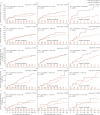Long-term prognostic value of longitudinal measurements of blood neurofilament levels
- PMID: 32817406
- PMCID: PMC7428358
- DOI: 10.1212/NXI.0000000000000856
Long-term prognostic value of longitudinal measurements of blood neurofilament levels
Abstract
Objective: To assess the long-term prognostic value of an integral of longitudinal measurements of plasma neurofilament light chain levels (NfLlong) over 12 and 24 months vs single neurofilament light chain (NfL) measurements in patients with relapsing-remitting MS (RRMS) and its additional value when combined with clinical and MRI measures.
Methods: This analysis included continuously fingolimod-treated patients with RRMS from the 24-month FTY720 Research Evaluating Effects of Daily Oral therapy in Multiple Sclerosis (FREEDOMS)/12-month Trial Assessing Injectable Interferon vs FTY720 Oral in Relapsing-Remitting Multiple Sclerosis (TRANSFORMS) phase 3 trials and their long-term extension, LONGTERMS. Patients were classified into high (≥30 pg/mL, n = 110) and low (<30 pg/mL, n = 164) NfL categories based on the baseline (BL) NfL value or the geometric mean NfLlong calculated over 12 and 24 months to predict disability-related outcomes and brain volume loss (BVL). The additional prognostic value of NfL was quantified using the area under the receiver operating characteristic (ROC) curve.
Results: A single high (vs low) NfL measure at BL was prognostic of a higher risk of reaching Expanded Disability Status Scale (EDSS) score ≥4 earlier (hazard ratio [HR] = 2.19; 95% CI = 1.21-3.97) and higher BVL over 120 months (difference: -1.12%; 95% CI = -2.07 to -0.17). When NfLlong was measured over 24 months, high NfL was associated with a higher risk of reaching EDSS score ≥4 (HR = 7.91; 95% CI = 2.99-20.92), accelerated 6-month confirmed disability worsening (HR = 3.14; 95% CI = 1.38-7.11), and 20% worsening in the Timed 25-Foot Walk Test (HR = 3.05; 95% CI = 1.38-6.70). Area under the ROC curve was consistently highest in models combining NfL with clinical and MRI measures.
Conclusions: NfLlong had a higher prognostic value than single NfL assessments on long-term outcomes in RRMS. Combining it with clinical and MRI measures increased sensitivity and specificity to predict long-term disease outcomes.
Classification of evidence: This study provides Class I evidence that NfLlong was more strongly associated with long-term outcomes than single NfL assessments in patients with RRMS.
Copyright © 2020 The Author(s). Published by Wolters Kluwer Health, Inc. on behalf of the American Academy of Neurology.
Figures



References
-
- Antel J, Antel S, Caramanos Z, Arnold DL, Kuhlmann T. Primary progressive multiple sclerosis: part of the MS disease spectrum or separate disease entity? Acta Neuropathol 2012;123:627–638. - PubMed
-
- Lassmann H, van Horssen J, Mahad D. Progressive multiple sclerosis: pathology and pathogenesis. Nat Rev Neurol 2012;8:647–656. - PubMed
-
- Teunissen CE, Khalil M. Neurofilaments as biomarkers in multiple sclerosis. Mult Scler 2012;18:552–556. - PubMed
Publication types
MeSH terms
Substances
LinkOut - more resources
Full Text Sources
Research Materials
